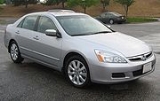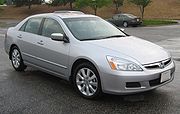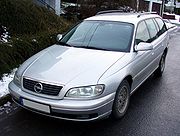
Mid-size car
Encyclopedia

North America
North America is a continent wholly within the Northern Hemisphere and almost wholly within the Western Hemisphere. It is also considered a northern subcontinent of the Americas...
n/Australia
Australia
Australia , officially the Commonwealth of Australia, is a country in the Southern Hemisphere comprising the mainland of the Australian continent, the island of Tasmania, and numerous smaller islands in the Indian and Pacific Oceans. It is the world's sixth-largest country by total area...
n standard for an automobile
Automobile
An automobile, autocar, motor car or car is a wheeled motor vehicle used for transporting passengers, which also carries its own engine or motor...
with a size equal to or greater than that of a compact
Compact car
A compact car , or small family car , is a classification of cars which are larger than a supermini but smaller than or equal to a mid-size car...
. In Europe
Europe
Europe is, by convention, one of the world's seven continents. Comprising the westernmost peninsula of Eurasia, Europe is generally 'divided' from Asia to its east by the watershed divides of the Ural and Caucasus Mountains, the Ural River, the Caspian and Black Seas, and the waterways connecting...
mid-sizers are referred to as D segment or large family cars.
The United States
The car that defined this size in the United StatesUnited States
The United States of America is a federal constitutional republic comprising fifty states and a federal district...
was the Rambler Six
Rambler Six
The Rambler Six and the Rambler V8 are intermediate sized automobiles that were built and marketed by American Motors Corporation from 1956 to 1960....
that was introduced in 1956, although it was called "compact" at that time. The mid-size class then grew out of the compacts of the early-1960s. For example, the Ford Fairlane
Ford Fairlane
- Automobiles :* Ford Fairlane , a car manufactured by the Ford Motor Company between 1955 and 1970* Ford Fairlane , a car manufactured by the Ford Motor Company of Australia between 1959 and 2007- See also :...
was referred to at its introduction in 1962 as a compact intermediate because it was barely bigger than its close relative, the Falcon. General Motors' first entries in the class, such as the Oldsmobile F-85, Pontiac Tempest
Pontiac Tempest
The Pontiac Tempest was an entry-level compact produced by the Pontiac Motor Division of General Motors, introduced in September 1960 for the 1961 model year....
, and Buick Special
Buick Special
In 1962, the Special was the first American car to use a V6 engine in volume production; it earned Motor Trends Car of the Year for 1962. This 198 in³ Fireball was engineered down from the 215 and used many of the same design parameters, but was cast in iron. Output was 135 hp at...
were not mechanically related to the compact Chevrolet Corvair
Chevrolet Corvair
-First generation :The 1960 Corvair 500 and 700 series four-door sedans were conceived as economy cars offering few amenities in order to keep the price competitive, with the 500 selling for under $2,000...
, but were similar in size. At that time vehicle classes were defined more by their wheelbase
Wheelbase
In both road and rail vehicles, the wheelbase is the distance between the centers of the front and rear wheels.- Road :In automobiles, the wheelbase is the horizontal distance between the center of the front wheel and the center of the rear wheel...
than interior passenger space and cargo capacity. The class began to grow rapidly, and for the next ten years each expansion in size in the full-size field was followed by a proportionate growth in the mid-size models. By the mid-1960s, they were as big as the full-size cars of the mid-1950s. By the mid-1970s, they were nearly as big as the full-size cars of the mid-1960s.
During the 1970s, the intermediate class was generally defined as vehicles with wheelbases between 112 inches (284 cm) and 118 inches (300 cm).A turning point occurred in the late 1970s, when rising fuel costs and government fuel economy regulations caused all car classes to shrink, and in many cases to blur. New "official" size designations in the U.S. were introduced by the EPA
United States Environmental Protection Agency
The U.S. Environmental Protection Agency is an agency of the federal government of the United States charged with protecting human health and the environment, by writing and enforcing regulations based on laws passed by Congress...
, which defined market segments by passenger and cargo space. Formerly mid-sized cars, like the AMC Matador
AMC Matador
The AMC Matador is a mid-size car that was built and sold by American Motors Corporation from 1971 to 1978. The Matador came in two generations: 1971 to 1973 and a major redesign from 1974 to 1978...
sedan that had a combined passenger and cargo volume of 130 cubic feet (3.68 m³), were now considered "full-size". The situation was complicated when General Motors began to downsize its models about two years before everybody else. In 1978, the Chevrolet Malibu
Chevrolet Malibu
Malibus and all other Chevelles were completely restyled for 1968 with semi-fastback rooflines on two-door hardtops and wheelbases split to on two-door models and 118 for four-door sedans and station wagons. Engine offerings included a new V8 rated at that replaced the V8 that had served as the...
nameplate had been redesigned on a 108 inches (274 cm) wheelbase, while the Ford Granada
Ford Granada (North America)
The Ford Granada was a mid-size car built and marketed by Ford Motor Company in North America from 1975–1982, along with its sister models, the Mercury Monarch, and Lincoln Versailles. The Granada was touted by Ford as a rival to the similarly sized Mercedes-Benz 280 of the time. The Granada and...
moved to the 105 inches (267 cm) wheelbase of the Ford Fairmont
Ford Fairmont
The Ford Fairmont is a compact car produced by Ford Motor Company for the North American market. Introduced for the 1978 model year, the Fairmont was produced in several bodystyles until it was replaced by the Ford Tempo for the 1984 model year...
's Fox
Ford Fox platform
The Ford Fox platform is a rear wheel drive, unitized-chassis, automobile architecture used by Ford Motor Company in North America. Introduced for the 1978 model year, it would go on to be produced until 1993 in its original version; a substantial redesign of the Ford Mustang in 1994 extended its...
platform in 1981. Both competed with the Chrysler standard and extended K-cars, often classified as compact, though mid-size by EPA standards. Former mid-size platforms such as the Plymouth Satellite
Plymouth Satellite
The Plymouth Satellite is an automobile introduced in 1965 as the top model in Plymouth's mid-size Belvedere line. The Satellite remained the top of the line model until the 1967 model year, where it became the mid-price model with the GTX taking its place as the top model. The Fury name was moved...
would be rebranded as full-size, rebodied, or dropped in the face of the downsized Chevrolet Caprice
Chevrolet Caprice
The Chevrolet Caprice is a full-sized automobile produced by the Chevrolet Division of General Motors in North America for the 1965 through 1996 model years. Full-size Chevrolet sales peaked in 1965 with over a million sold. It was the most popular American car in the sixties and early seventies....
. Some were subsequently replaced by what used to be large compacts, like the Plymouth Gran Fury
Plymouth Gran Fury
The Plymouth Gran Fury is an automobile manufactured by the Chrysler Corporation to signify Plymouth's largest full-size automobile from 1975 to 1977. The nameplate would be used on successive downsizings, first in 1980, and again in 1982, through what would originally have been intermediate and...
in police applications. The Granada would be badged with the (formerly full-size) LTD moniker before being replaced by the class-defining Ford Taurus
Ford Taurus
The Ford Taurus is an automobile manufactured by the Ford Motor Company in the United States. Originally introduced in the 1986 model year, it has remained in near-continuous production for more than two decades, making it the fourth oldest nameplate that is currently sold in the North American...
. Similarly, import models such as the Honda Accord
Honda Accord
The Honda Accord is a series of compact, mid-size and full-size automobiles manufactured by Honda since 1976, and sold in a majority of automotive markets throughout the world....
and Toyota Camry
Toyota Camry
The Toyota Camry is a series of mid-size automobiles manufactured by Toyota since 1982, and sold in the majority of automotive markets throughout the world...
that had been classified by the EPA as compact in 1985 grew to the mid-size class by the 1990s. The Accord has since grown larger; its current North American sedan version
Honda Accord (North America eighth generation)
The North American eighth generation Honda Accord is a mid-size sedan and coupe introduced for the 2008 model year. It is also marketed in parts of Asia and as the Honda Inspire in Japan....
is classified by the EPA as a full-size car, although its coupe version remains in the mid-size class.
Mid-size vehicles today usually have wheelbases between 105 inches (267 cm) and 110 inches (279 cm). Another widely used definition is that of the EPA, which classifies cars between 110 cubic feet (3.11 m³) and 119 cubic feet (3.37 m³) of interior volume as mid-size. This is currently the most popular size car sold in the United States.
Europe, Australia and New Zealand

Ford Mondeo
The Mondeo was launched on 8 January 1993, and sales began on 22 March 1993. Available as a four-door saloon, a five-door hatchback, and a five-door estate, all models for the European market were produced at Ford's plant in the Belgian city of Genk...
weighed around 1300 kg (2,866 lb), had a 2704 mm (106.5 in) wheelbase, and was often powered by a 2.0 L I4.
European and Australasian mid-size/large family cars are also usually offered in sedan and hatchback form, as opposed to the sole sedan form found in the models populating the North American category. European mid-size cars tend to be front-wheel drive with a focus on ride comfort, although the twisting nature of European roads demands a high level of handling agility which would not normally be required in the USA.
As elsewhere, upsizing has blurred the distinction between types, with models that and are considered compacts in North America, such as the Ford Focus and Opel Astra
Opel Astra
The Opel Astra is a small family car engineered and manufactured by the German automaker Opel since 1991.It is branded as Vauxhall Astra in the United Kingdom, the Buick Excelle XT in China and the Chevrolet Astra/Vectra in Latin America...
, approaching the mid-size category by growing larger and fitting more powerful engines with every iteration. However, it is usually thought that the categories grow along the years rather than the cars switching categories.
Sometimes the definitions of car categories are manipulated to serve marketing ends. In Australia, Toyota had categorized the V6 equipped Camry as a large car and the 4-cylinder Camry as a medium or mid-size car in order to dominate more segments, despite the physical size of the cars being identical. Similarly, the Opel/Vauxhall Omega
Opel Omega
The Opel Omega was an executive car marketed by the German automaker Opel between 1986 and 2003 in two generations, both manufactured at Opel's Rüsselsheim, Germany plant. The first generation, the Omega A , superseded the Opel Rekord, was voted European Car of the Year for 1987, and was available...
/Cadillac Catera, which had dimensions right on the border between the North American categorizations of full-size and mid-size, was marketed as a luxury full-size car in Europe and a mid-size car in North America.
Japan
In Japan, the term mid-size car probably does not have the intermediate sense that it does in other markets. Due to space restrictions the range of cars available in this market starts from a much smaller size. As such, the models that Japan exports to other markets to compete in mid-size market segments such as the Mazda 6 and Subaru LegacySubaru Legacy
The Subaru Legacy is a mid-size car built by the Japanese company Fuji Heavy Industries, and manufactured by its division Subaru since 1989, and is available as a sedan or wagon. Part of the original design goals for the Legacy model was to provide Subaru a vehicle in which they could compete in...
Honda Inspire (Accord US Version) occupy a more exclusive segment in the Japanese marketplace.
An interesting quirk of Japanese automotive tax codes is that width is one of factors determining which category a car is taxed under. The standards state any vehicle that is more than 4.7 m (15.4 ft) long, 1.7 m (5.6 ft) wide, 2 m (6.6 ft) high or with engines larger than 2000cc is what is called a "passenger size vehicle". This regulation also mandates that all passenger vehicles can not exceed 5 m (16.4 ft) length or 1.8 m (5.9 ft) width. Therefore even mid-sized cars destined for export markets from Japan had widths of less than 1700 mm (66.9 in), as manufacturers had to look to domestic consumption as well as export. However, as export markets have become progressively more significant for Japanese car manufacturers, more models have been produced that break this 1700 mm (66.9 in) wide limit.
See also
- Car classificationCar classificationCars may be classified by a number of different criteria; however, comprehensive classification is elusive, because a vehicle may fit into multiple categories, or not completely satisfy the requirements for any. This article details the most commonly used systems of classification. Where...
- Vehicle size classVehicle size classVehicle size classes are a way of classifying cars. The common North American parlance is word-based, while English-speaking European writers also use words to describe car sizes...
- Large family carLarge family carA large family car, also known as a D-segment car, is a European automobile classification which is larger than a small family car and smaller than an executive car. Multi-purpose vehicles based on a large family car design are often called large MPVs, while similarly-priced models from luxury car...
- Executive carExecutive carExecutive car is a British term that refers to a car's size and is used to describe an automobile larger than a large family car. In official use, the term is adopted by EuroNCAP, a European organisation founded to test car safety.- History :...
External links
- A chart of mid-size (and other sized) cars, arranged by company
- EPA list of 1985 midsize cars
- EPA list of 1988 midsize cars
- EPA list of 1990 midsize cars
- EPA list of 1994 midsize cars
- EPA list of 1998 midsize cars
- EPA list of 2000 midsize cars
- EPA list of 2008 midsize cars
- EPA list of 2009 midsize cars
- EPA list of 2010 midsize cars
- EPA list of 2011 midsize cars

